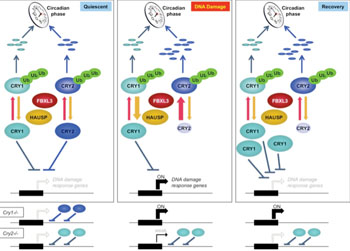Two Proteins Critical for Circadian Cycles Protect Cells from Mutations
By LabMedica International staff writers
Posted on 18 Mar 2015
Scientists have discovered that two proteins critical for maintaining healthy day-night cycles also have an unexpected role in DNA repair and protecting cells against genetic mutations that could lead to cancer and other diseases.Posted on 18 Mar 2015
The new study was carried out by researchers from The Scripps Research Institute (TSRI; La Jolla, CA, USA). “These proteins play an important role in the response to DNA damage,” said senior author Katja Lamia, “Researchers might eventually harness that knowledge for pharmaceutical targeting.”

Image: Model depiction of a novel cellular mechanism by which regulation of cryptochromes Cry1 and Cry2 enables coordination of a protective transcriptional response to DNA damage caused by genotoxic stress (Photo courtesy of the journal eLife, March 2015, Papp SJ, Huber AL, et al.).
People with unusual sleep schedules, such as flight attendants or rotating night-shift nurses, are at higher risk for certain health problems. The human body senses light and adjusts rhythms to the day-night cycle via the circadian clock. Hunger and sleepiness, for example, are strongly influenced by this clock. “When you have a deregulation of your circadian clock, you’re more prone to develop some kind of pathology, like diabetes, cancer, or heart disease,” said co-first author and research associate Anne-Laure Huber.
To investigated a possible cause of these health disparities, the team focused on the role of the circadian transcriptional repressors cryptochrome 1 (Cry1) and 2 (Cry2), which evolved from bacterial light-activated DNA repair enzymes. While cryptochromes are no longer light-activated, they do hold to a daily-regulated schedule, and stability of Cry1 and Cry2 is critical for circadian clock function. In humans, cryptochromes are essential for regulating blood sugar levels and protein production on a day-night cycle, but no longer have a direct role in DNA repair activity.
The study was initiated with proteomic screening to fish out proteins that could bind Cry1 or Cry2. The team found that Cry1 could bind Hausp, which has a known role in regulating the anti-cancer protein p53. The screening also showed that Hausp binds Cry2, but less strongly, suggesting that the nearly identical Cry1 and Cry2 have different roles related to DNA repair. “Most of the time people study them as redundant proteins, but we show that they have distinct functions in this DNA-repair pathway,” said Dr. Lamia.
Genetic expression experiments then showed that Hausp stabilizes Cry1, which helps prevent potential errors in DNA transcription that could occur upon DNA exposure to radiation. “This is very cool,” said co-first author and graduate student Stephanie Papp, “These proteins can sense that something is wrong in the cells.” When the researchers blocked Cry2 production, the cells no longer activated p21, a protein that stops mutant cells from dividing. “This could suggest that cells without Cry2 would be more susceptible to cancer,” said Dr. Lamia.
These and additional findings of the study showed that while Cry1/2 no longer directly repair DNA, they have adapted to provide an indirect role in the repair process, protecting genomic integrity via coordinated transcriptional regulation. This new link between circadian clock proteins and DNA repair is a clue to how disrupting day-night cycles could harm health.
The study, by Papp SJ, Huber AL, et al, was published March 10, 2015, in the journal eLife.
Related Links:
The Scripps Research Institute













